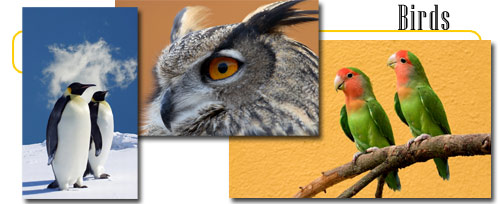|

Just The Facts: Birds are bipedal, warm-blooded, oviparous vertebrate animals characterized primarily by feathers, forelimbs modified as wings, and (in most) hollow bones.
Birds range in size from the tiny hummingbirds to the huge Ostrich and Emu. Depending on the taxonomic viewpoint, there are about 8,800–10,200 living bird species (and about 120–130 that have become extinct in the span of human history) in the world, making them the most diverse class of terrestrial vertebrates.
You Eat Like a Bird! Birds feed on nectar, plants, seeds, insects, fish, mammals, carrion, or other birds.
A Day in the Life: Most birds are diurnal, or active during the day, but some birds, such as the owls and nightjars, are nocturnal or crepuscular (active during twilight hours), and many coastal waders feed when the tides are appropriate, by day or night.
Migration Nation: Many birds migrate long distances to utilise optimum habitats (e.g., Arctic Tern) while others spend almost all their time at sea (e.g. the Wandering Albatross). Some, such as Common Swifts, stay aloft for days at a time, even sleeping on the wing.
Platonic Ideal Bird: Common characteristics of birds include a bony beak with no teeth, the laying of hard-shelled eggs, high metabolic rate, a 4-chambered heart, and a light but strong skeleton. Most birds are characterised by flight, though the ratites are flightless, and several other species, particularly on islands, have also lost this ability. Flightless birds include the penguins, ostrich, kiwi, and the extinct Dodo. Flightless species are vulnerable to extinction when humans or the mammals they introduce arrive in their habitat. The Great Auk, flightless rails, and the moa of New Zealand, for example, all became extinct due to human influence.
Birds are among the most extensively studied of all animal groups. Hundreds of academic journals and thousands of scientists are devoted to bird research, while amateur enthusiasts (called birdwatchers, twitchers or, more commonly, birders) probably number in the millions.
Tyrannosaurus Tweety: There is significant evidence that birds evolved from theropod dinosaurs, specifically, that birds are members of Maniraptora, a group of theropods which includes dromaeosaurs and oviraptorids, among others.[1] As more non-avian theropods that are closely related to birds are discovered, the formerly clear distinction between non-birds and birds becomes less so. Recent discoveries in northeast the People's Republic of China (Liaoning Province), demonstrating that many small theropod dinosaurs had feathers, contribute to this ambiguity.
The basal bird Archaeopteryx, from the Jurassic, is well-known as one of the first "missing links" to be found in support of evolution in the late 19th century, though it is not considered a direct ancestor of modern birds. Confuciusornis is another early bird; it lived in the Early Cretaceous. Both may be predated by Protoavis texensis, though the fragmentary nature of this fossil leaves it open to considerable doubt if this was a bird ancestor. Other Mesozoic birds include the Enantiornithes, Yanornis, Ichthyornis, Gansus and the Hesperornithiformes, a group of flightless divers resembling grebes and loons.
The recently discovered dromaeosaur Cryptovolans was capable of powered flight, possessed a sternal keel and had ribs with uncinate processes. In fact, Cryptovolans makes a better "bird" than Archaeopteryx which is missing some of these modern bird features. Because of this, some paleontologists have suggested that dromaeosaurs are actually basal birds whose larger members are secondarily flightless, i.e. that dromaeosaurs evolved from birds and not the other way around. Evidence for this theory is currently inconclusive, but digs continue to unearth fossils (especially in China) of the strange feathered dromaeosaurs. At any rate, it is fairly certain that avian flight existed in the mid-Jurassic and was "tried out" in several lineages and variants by the mid-Cretaceous.
Scientific Classification:
SUBCLASS NEORNITHES
Paleognathae:
* Struthioniformes, Ostrich, emus, kiwis, and allies
* Tinamiformes, tinamous
Neognathae:
* Anseriformes, waterfowl
* Galliformes, fowl
* Gaviiformes, loons
* Podicipediformes, grebes
* Procellariiformes, albatrosses, petrels, and allies
* Sphenisciformes, penguins
* Pelecaniformes, pelicans and allies
* Ciconiiformes, storks and allies
* Phoenicopteriformes, flamingos
* Accipitriformes, eagles, hawks and allies
* Falconiformes, falcons
* Gruiformes, cranes and allies
* Charadriiformes, gulls, button-quail, plovers and allies
* Pteroclidiformes, sandgrouse
* Columbiformes, doves and pigeons
* Psittaciformes, parrots and allies
* Cuculiformes, cuckoos, turacos, hoatzin
* Strigiformes, owls
* Caprimulgiformes, nightjars and allies
* Apodiformes, swifts and hummingbirds
* Coraciiformes, kingfishers
* Piciformes, woodpeckers and allies
* Trogoniformes, trogons
* Coliiformes, mousebirds
* Passeriformes, passerines
Note: This is the traditional classification (the so-called Clements order). A radically different classification based on molecular data has been developed (the so-called Sibley-Monroe classification or Sibley-Ahlquist taxonomy). This has influenced taxonomical thinking considerably, with the Galloanserae proving well-supported by recent molecular, fossil and anatomical evidence[citation needed]. With increasingly good evidence, it has become possible by 2006 to test the major proposals of the Sibley-Ahlquist taxonomy. The results are often nothing short of astounding, see e.g. Charadriiformes or Caprimulgiformes.
All text is available under the terms
of the GNU Free Documentation License
|

